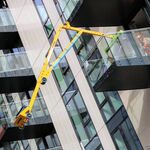afransen
Senior Member
This is the problem I have with Toronto's fascination with trying to convert arterial roads to urban streets. Arterials should be for moving vehicles at relatively high speed, which is incompatible with complex urban environments. Complex urban environments should have speed limits and design speeds of 30 kph for safety of road users. Then bollards make sense as vehicles driving 30 kph won't be at much risk.Traffic barricades perform a combination of either re-directing and/or absorbing kinetic energy. The faster they do this, generally less space is needed, the greater the risk to the soft, squishy occupants of the vehicle but less risk to the soft, squishy people they are intended to protect (not counting flying bits that are still exhibiting kinetic energy). The more gradually and less lethally they do it, generally more space is needed, which may not always be available in an urban setting.





